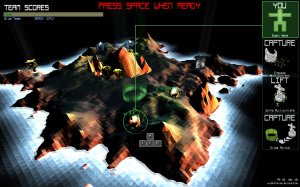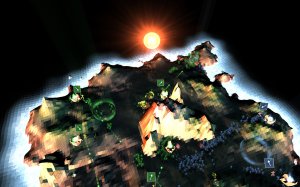Three years ago any article about Introversion and its games would have been prefaced with something along the lines of “you might not have heard of them, but…” In 2005 sales were not matching the critical acclaim for early titles Uplink and Darwinia, with only a small but loyal fanbase standing between the UK team and the place where developers go to die.
At the same time Valve’s delivery platform, Steam, was in the throes of reinventing itself, transforming from a clunky Half Life 2/Counterstrike front-end into the massive online store and community it is today. Part of its new remit was to locate independent games and bring them to the masses, with Darwinia becoming one of the first to benefit from Steam’s wide userbase. Introversion’s fortunes flipped overnight, boosted even further by receiving high profile awards at the Independent Games Festival, and they were suddenly on the map, in the money and looking to the future.
Preview: Multiwinia
Which brings us neatly to Multiwinia, a multiplayer sort-of sequel to their earlier classic. Multiplayer options were conspicuous by their absence in Darwinia, so it’s a natural step forwards; the question is whether there’s going to be enough to justify Multiwinia’s existence as standalone title and whether existing Darwinia fans will feel compelled to part with more of their cold, hard cash.
Gameplay
 One problem that afflicted Darwinia and no doubt contributed to its initially slow sales was its unusual interface. While it was a slick and involving system once you had grasped the basics, it was so different to anything seen before – or since – that it was less of a learning curve and more of a vertical cliff-face without any safety wire. Or hands. Although this was partially rectified in later updates there remained a geek barrier between the game and more casual players. A single player game can occasionally survive such a handicap; a multiplayer game will suffer if players are unable to grasp the gameplay potential quickly.
One problem that afflicted Darwinia and no doubt contributed to its initially slow sales was its unusual interface. While it was a slick and involving system once you had grasped the basics, it was so different to anything seen before – or since – that it was less of a learning curve and more of a vertical cliff-face without any safety wire. Or hands. Although this was partially rectified in later updates there remained a geek barrier between the game and more casual players. A single player game can occasionally survive such a handicap; a multiplayer game will suffer if players are unable to grasp the gameplay potential quickly.
 Multiwinia immediately makes a better first impression, with a stylish but decidedly standard menu setup that provides useful information on each game mode and enables you to get playing quickly. Once the playing area has loaded on-screen prompts highlight the crucial areas, performing much of the same role as the movies accompanying each of Team Fortress 2’s maps. By the time the match begins you already know where you should be heading and what you should do when you get there. An interactive tutorial is also included that should get complete beginners up to speed.
Multiwinia immediately makes a better first impression, with a stylish but decidedly standard menu setup that provides useful information on each game mode and enables you to get playing quickly. Once the playing area has loaded on-screen prompts highlight the crucial areas, performing much of the same role as the movies accompanying each of Team Fortress 2’s maps. By the time the match begins you already know where you should be heading and what you should do when you get there. An interactive tutorial is also included that should get complete beginners up to speed.
If you’ve played Darwinia you’ll feel right at home here, although that’s not to say that Introversion haven’t made some substantial changes. The implicit control system for the Darwinians themselves remains, with ‘officers’ pointing the way for the little critters who otherwise behave autonomously. However, you can also gather up a small selection of the green chappies and direct them to a spot manually, although their behaviour on the way and once they arrive is still in the hands of their AI. Pathfinding has been improved drastically, with Darwinians no longer able to get irrevocably defeated by a small, polygonal hill.
The autonomy of the Darwinians neatly avoids the tedious micro-management of other RTS games, in which you often find yourself desperately juggling the needs of hundreds of individual units rather than focusing on the battle itself. Too many supposed strategy games concern themselves with feeding the troops rather than commanding them – you wouldn’t have found Field Marshall Hague or Alexander the Great serving up in the canteen. In Multiwinia you instruct your troops and they obey without question – their survival depends upon their numbers and your carefully considered strategy.
 Although there are additional units that can be accessed by capturing upgrade crates that fall from the digital sky, the game is kept generally simple and focused on the Darwinians. While RTS purists might balk at this, the result is that it’s less about which unit you use and more about what you do with it. It levels the playing field to a degree and enables player skill to shine. Although it’s impossible to tell until the game goes live, it may also finally resolve the eternal problem of multiplayer RTS games – the ‘rush’ tactic, which sees expert gamers making hundreds of precision clicks a minute in order to assemble an army of statistically perfect units before you’ve even had time to take in the scenery. When there’s only one main unit, that’s not really an option.
Although there are additional units that can be accessed by capturing upgrade crates that fall from the digital sky, the game is kept generally simple and focused on the Darwinians. While RTS purists might balk at this, the result is that it’s less about which unit you use and more about what you do with it. It levels the playing field to a degree and enables player skill to shine. Although it’s impossible to tell until the game goes live, it may also finally resolve the eternal problem of multiplayer RTS games – the ‘rush’ tactic, which sees expert gamers making hundreds of precision clicks a minute in order to assemble an army of statistically perfect units before you’ve even had time to take in the scenery. When there’s only one main unit, that’s not really an option.
One final word of warning: the preview code given out to us journos is, rather perplexingly, single player only. Presumably this is an attempt to curb piracy through leaked copies, but it does leave me in the rather odd position of reviewing a game that is specifically about multiplayer in an entirely offline environment. However, it does highlight that playing the computer is still remarkably good fun, thanks to several core concepts being carried over from the original single player game, so at least Multiwinia will still be worth playing if your Internet connection breaks.
Sound & Vision
Visuals remain largely unchanged from Darwinia, although the preview copy seemed to be missing a few bells and whistles such as reflecty water; these may yet show up in the final game. It’s a uniquely retro look, mixing TRON with early Amiga games to create a nostalgic neon landscape of sharp-edged polygons and simple 2D creatures. Whether you take to it or not will depend much on your age and love of the 80s, but there’s no denying the awe of hundreds of Darwinians colliding together like a simplistic Lord of the Rings animatic, or the sad sight of hundreds of the little fellas running about on fire after their troop transport is blown to pieces.
 The greatest success of the visuals is in keeping the armies separate and distinct. By using a limited and primary palette, you can always spot your armies, no matter where your camera is currently pointing. Even if you have troops positioned on the other side of the map, you can easily pick them out amongst hundreds of other moving pieces.
The greatest success of the visuals is in keeping the armies separate and distinct. By using a limited and primary palette, you can always spot your armies, no matter where your camera is currently pointing. Even if you have troops positioned on the other side of the map, you can easily pick them out amongst hundreds of other moving pieces.
Introversion really nailed the use of sound in games with DEFCON, creating a soundtrack that made an abstract and detached multiplayer game into a highly visceral and haunting experience. With Multiwinia they make the digital playground feel very much alive, with the beeps and chirrups of Darwinians merging with the pulsing of lasers and the electronic hum of power-up crates descending from above – very literal deus ex machina. When arranged in glorious 5.1 surround sound it’s a soundscape that makes every battle feel immediate and exciting.
Remaining questions
Multiwinia is great fun in its current state, with a couple of months yet to go before release. Several questions remain, however, not least of which is its actual multiplayer credentials. The single player preview code shows off the game’s fantastic art design, technical prowess and slick interface but does little to show the stability of the online mechanisms, or how battles will play out against human opponents. Until this has been properly playtested it’s hard to properly assess the game’s potential.
 The preview demonstrated two game modes – a traditional base-capturing mode called ‘King of the Hill’, similar to the Battlefield model, and an innovative ‘capture the statue’ mode in which you have to shepherd giant icons around the map – both of which played well and were suitably different. The remaining four modes have yet to be tested. Variety is the key to the longevity of multiplayer games, so much will depend on each mode offering something unique.
The preview demonstrated two game modes – a traditional base-capturing mode called ‘King of the Hill’, similar to the Battlefield model, and an innovative ‘capture the statue’ mode in which you have to shepherd giant icons around the map – both of which played well and were suitably different. The remaining four modes have yet to be tested. Variety is the key to the longevity of multiplayer games, so much will depend on each mode offering something unique.
The biggest hurdle to jump is the same one that brought Darwinia to its knees: accessibility. Will new players flocking to the game on Steam be able to master the unusual control scheme? Will the eccentric re-conceptualising of the RTS genre appeal or simply confuse people? Will hardcore Starcraft players be disappointed by the lack of units and micro-management? If the casual and the hardcore don’t buy into the idea it could be a bumpy road for Introversion, but Multiwinia’s subtle interface tweaks and exciting, innovative gameplay should hopefully bring it to PC audiences that seem increasingly interested in independent, unusual titles. The best result of all, of course, would be if through increased awareness Multiwinia finally brought Darwinia the sales and recognition it deserves.
Part One:
Part Two:




0 Comments
Ben Bayliss · August 1, 2008 at 12:50 pm
Although I haven’t really has a great deal of knowledge on Darwinia I have constantly heard about it through steam and whatnot, Multiwinia though I hadn’t heard about until you mentioned you were going to be reviewing it. Well this looks like a well thought out game and I enjoyed reading the history about the company and the game so well done there! Upon reading this review though I’m actually dying to buy Darwinia, learning it then possibly upgrading to Multiwinia.
Can’t wait for the future previews to come, keep it up!
Ben
Nutter · August 3, 2008 at 3:23 pm
Nice preview and excellent video(s) 🙂
Simon Jones · August 4, 2008 at 7:30 pm
Thanks! Glad you enjoyed it, Nutter!
And Ben – you definitely should look into grabbing a copy of Darwinia, especially as it’s so insanely cheap on Steam. In fact, get the Darwinia/Uplink pack, as Uplink is also superb (although pretty hardcore). Two British classics for a tenner – what’s stopping you? 🙂
Erez · August 19, 2008 at 9:48 pm
I think this preview is verry well written, and the videos are good, you explained just the right things, nice.
Simon Jones · August 19, 2008 at 10:20 pm
Hi Erez! Thanks for the kind comments, much appreciated. I’ve only recently started this blog, so it’s really encouraging to hear from people that have enjoyed reading articles.
tals · September 13, 2008 at 1:24 pm
Nice preview – really looking forward to release now. Out of interest World In Conflict has the same control scheme for the camera 🙂
Simon Jones · September 13, 2008 at 1:29 pm
Yeah, I’ve had a few people mention WiC’s camera controls to me now. I played the demo, briefly, when it came out, but had since completely forgotten about it. With luck other devs will start using that control system where appropriate. Playing Company of Heroes at the moment, I really miss the ease with which you can move around in Dar/Multiwinia.